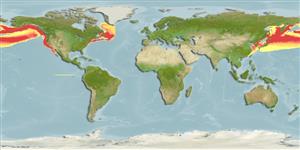>
Aulopiformes (Grinners) >
Anotopteridae (Daggertooth)
Etymology: Anotopterus: Greek, a = without + Greek, noton = back + Greek, pteron = fin (Ref. 45335); nikparini: Named for Nikolai V. Parin.
Eponymy: Professor Dr Nikolai Vasilyevich Parin (1932–2012). (see Parin, also see Nik) (Ref. 128868), visit book page.
Environment: milieu / Klimaatzone / Diepte / distribution range
Ecologie
marien bathypelagisch; diepte 0 - 2750 m (Ref. 31260), usually 0 - 700 m (Ref. 31260). Temperate
North Pacific: Bering Sea and Gulf of Alaska; south in Pacific waters to about 25°N, south of Baja California and Japan.
Grootte / Gewicht / Leeftijd
Maturiteit: Lm ? range ? - ? cm
Max length : 146 cm TL mannelijk / geslacht onbekend; (Ref. 6885); max. gepubliceerd gewicht: 1.7 kg (Ref. 6885)
Korte beschrijving
Determinatiesleutels | Morfologie | Morfometrie
Dorsale stekels (totaal) : 0; Dorsale zachte stralen (totaal) : 0; Anale stekels: 0; Anale zachte stralen: 14 - 17; Wervels: 78 - 80. Dark brownish, silvery ventrally; paired fins and caudal fin uniformly black. Body extremely elongate. Large adults with a pair of dermal keels midlaterally on each side. Small, flexible projection at tip of lower jaw. Gill membranes joined forward, below anterior edge of eye, and free from isthmus. No rayed dorsal fin. No scales (Ref. 43939). In adults, head depth 29-33% of lower jaw length. Postorbital area 8.1-9.7% SL or 34.4-38.8% (less than 3 times smaller than HL). Rear edge of gill cover overlaps with the vertical of the 5th vertebrae. Postadipose distance 7-8% SL (Ref. 31260).
Body shape (shape guide): eel-like; Cross section: compressed.
Found in a wide range of depths, sometimes near surface (Ref. 2850) to below 2,000 m. Larger adults inhabit colder water toward the poles, whereas, the young and smaller adults inhabit more temperate regions (Ref. 35956). Feed on mollusks, crustaceans, marine worms, coelenterates, salps, and fishes (Ref. 4525, 6885). Its distensible body wall and large stomach can accommodate prey up to half of its own length. Oviparous, with planktonic larvae (Ref. 35956). Preyed upon by albacore, Pacific lancetfish, halibut, steelhead salmon, blue shark, pomfret, and whales (Ref. 6885).
Levenscyclus en paargedrag
Maturiteit | Voortplanting | Paaien | Eieren | Fecunditeit | Larven
Kukuev, E.I., 1998. Systematics and distribution in the world ocean of daggertooth fishes of the genus Anotopterus (Anotopteridae, Aulopiformes). J. Ichthyol. 38(9):716-729. (Ref. 31260)
Status op de Rode Lijst van het IUCN (Ref. 130435: Version 2024-2)
Gevaar voor de mens
Harmless
Gebruik door de mens
Tools
Speciale rapporten
Download XML
Internetbronnen
Estimates based on models
Preferred temperature (Ref.
123201): 1.4 - 15.3, mean 5.7 °C (based on 3019 cells).
Fylogenetische diversiteitsindex (Ref.
82804): PD
50 = 0.7500 [Uniqueness, from 0.5 = low to 2.0 = high].
Bayesian length-weight: a=0.00102 (0.00046 - 0.00225), b=3.06 (2.88 - 3.24), in cm total length, based on all LWR estimates for this body shape (Ref.
93245).
Trofisch niveau (Ref.
69278): 4.5 ±0.5 se; based on diet studies.
Generation time: 2.2 ( na - na) years. Estimated as median ln(3)/K based on 1
growth studies.
Weerstandsvermogen (Ref.
120179): Gemiddeld, minimale populatieverdubbelingstijd 1,4-4,4 jaar (K=0.5).
Fishing Vulnerability (Ref.
59153): Very high vulnerability (88 of 100).
🛈
